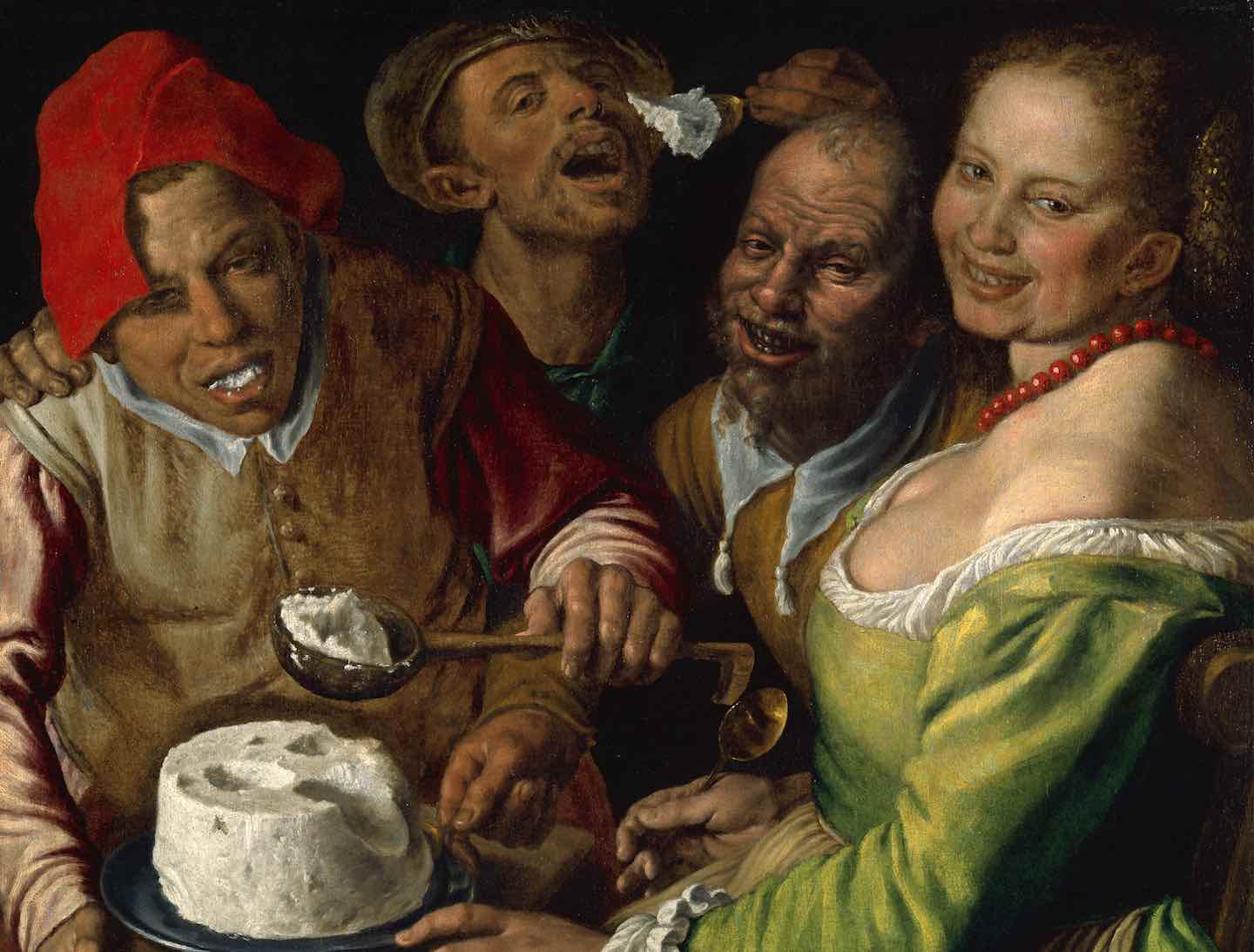At Mathias Énard’s Table
Set between the 16th and 22nd centuries, The Annual Banquet of the Gravediggers’ Guild is a work of political comedy, fixated on class, climate, food, wine, and the afterlife.
At Mathias Énard’s Table
Set between the 16th and 22nd centuries, The Annual Banquet of the Gravediggers’ Guild is a work of political comedy, fixated on class, climate, food, wine, and the afterlife.

The Ricotta Eaters, Vincenzo Campi (c. 1585). Found in the Collection of Musée des Beaux-Arts, Lyon.
(Photo by Fine Art Images / Heritage Images / Getty Images)The French novelist Mathias Énard sets his obsessive characters within the high contrast of a cultural or political confusion. The much-lauded Zone (2008)—written as a single, 150,000-word sentence—inhabits the mind of Francis Servain Mirkovic, a Parisian spy selling a grisly dossier of Mediterranean violence to a representative from the Vatican. Compass, winner of the 2015 Prix Goncourt, centers on the Austrian musicologist Franz Ritter, who spends an insomniac vigil recounting his academic career as a postcolonial Orientalist. These avatars navigate a fluid cultural history in which influence, atrocity, and appreciation maintain an uneasy equilibrium. Whether parsing sectarian violence, predatory globalism, artistic hybridity, or revolutionary fallout, Énard offers a vision of modern life—and the modern novel—as a pattern of disclosure partially obscured by complex and nonlinear histories.
Books in review
The Annual Banquet of the Gravediggers’ Guild
Buy this bookAt first glance, his latest novel, The Annual Banquet of the Gravediggers’ Guild, appears to follow in this tradition. It opens with the diary of David Mazon, an anthropology student in his mid-30s who moves from Paris to La Pierre-Saint-Christophe, a village in western France, to work on his doctoral dissertation on contemporary agrarian life. (He names his farmhouse room “The Savage Mind,” a reference to Claude Lévi-Strauss.) The fish-out-of-water premise—cartoonishly vain urban intellectual finds himself amid humble countryfolk—activates a recognizably Énardian strain of humor. David spends his days puttering around on a secondhand moped, drinking Orangina at Café-Peche, the village’s sole bar, and avoiding his thesis by way of Tetris and the occasional lewd Skype call with his girlfriend in Paris. He meets various villagers—including Martial, the mayor and head undertaker; Max, an artist who photographs his bowel movements; and Lucie, an activist farmer—all the while convinced he’s circling a big idea: “The countryside is the true melting pot, the place where wildly diverse lifestyles co-exist.”
And he’s right, only not in the way he believes. Unbeknownst to David or any of the village residents, the souls of La Pierre-Saint-Christophe are endlessly reforged in the crucible of metempsychosis, oblivious riders of what the novel calls the “Wheel of Suffering.” Whenever one thing dies—be it human, animal, or insect—it comes back as something else, sometimes in the past and other times in the distant future. A priest becomes a rutting shoat; a serial killer is doomed to cycles of lowly wormhood; a dying she-wolf will become, over time, a well-digger, a bombardier, a bar owner in Beauvoir-sur-Niort, and an innkeeper. If these comeuppances are sometimes too tidy, they furnish the novel’s teeming palimpsest with rich embroidery. Énard spins the ever-turning Wheel with the capricious force of his digressions.
Having abandoned David—whom we’ll return to much later—some 80 pages in, the novel takes a turn toward miscellany. We are treated to freewheeling and appealingly wobbly chapters replete with letters, product names, lyrics, poems, speeches, ballads, testimonials, and references to murders and wars. These dispatches often revolve around members of the village or their direct descendants, a tracking of past and future lives as they move back and forth upon the Wheel. La Pierre-Saint-Christophe blurs with convergence and intersection as family trees bear branches in reverse. Posthumous escapades enlarge or obscure the contemporary residents; between these stories are shorter sections that reveal the fates of individuals whom we never hear from again. These interludes are called “Songs,” perhaps referencing the novel’s Father Largeau—the aforementioned hog-to-be—who listens for the “deep bass song of the divine” throughout his life. That cosmic melody—sometimes rhapsodic, sometimes dissonant or atonal—orchestrates the novel, binding the disparate characters into loose networks of karmic reciprocation and rebirth.
But for all the idiosyncratic locality of the past, something is awry here. An inequality of attention exists within the novel’s temporal structure—namely, the future-spawned souls are rarely seen. When they do appear, they act as mere functionaries—brief, portentous signals of the coming climate chaos—rather than figures of robust and unpredictable life. Their impending horror is often no sooner suggested than dismissed, abandoned to the relative narrative safety of the past. When the soul of the French explorer René Caillié is cast forth into “the twenty-second century of Great Drought and desolation, when everything was dying,” one might reasonably expect an account of that soul’s tribulations. But after a cryptic allusion to “the renewal of Times,” we find ourselves back in the 16th century, returned to the well-trod French history from which Énard extracts dozens of charming or tragic tales. Are there really no souls beyond the 22nd century? No animals or insects in the Wheel’s deep future? We merely infer our proximity to extinction, unsatisfactory not so much for its grimness as its insufficient realization.
That feeling—call it strategically vague fatalism—builds throughout. The future is too brightly lit by its narrative function, seemingly appended to the novel’s surface. It is arid in conception, particularly when compared to the richly textured sense of the past and present. Our catastrophe demands full immersion, or else the kind of tactful circumvention that trusts readers to already know the truth: that all contemporary fiction is climate fiction to one extent or another. Longtime readers of Énard know he’s capable of subtler devastations than such perfunctory mining into the apocalyptic substrate.
The novel’s eponymous banquet is in many ways its centerpiece, a grand bacchanal celebrating Death’s mystical hiatus, a two-day reprieve during which the guild will dig no graves. It is written in Rabelaisian pastiche (translator Frank Wynne likely had his hands full) and structured as a kind of riotous debate or mock-philosophical orgy. The gravediggers—alcoholic semi-divinities steeped in ambivalence—adhere to a rigorously debauched schedule. They discuss the state of their industry, including eco-conscious solutions for the modern bereaved and the potential admittance of women into the profession, before moving on to bawdy tales, interminable songs, toasts, baroque insults, long (and sometimes tedious) monologues, and impossible quantities of the region’s finest wines. Your enjoyment of this section will largely depend upon your appetite for archaic literary forms. It seems to me an overlong joke with a Joycean punch line: The return of suffering compels the return of style.
Not everything is fated to recur. Change is afoot in La Pierre-Saint-Christophe, and with it a host of reactionary suspicions and revolutionary gambits. The villagers fear an erosion of tradition at the hands of “Arabs”: “Our whole way of life could collapse, you know, the social security system, education, these things are fragile,” Martial, the mayor cum undertaker, says. Elsewhere, small farmers sabotage artificial reservoirs, their livelihoods “wiped out by vast Bayer agribusinesses on one hand and rurbanisation on the other.” The logic of global capital has erected its own wheel-within-the-Wheel, a less metaphysical, more material vision of suffering in the here and now. Énard is most successful in this mode, in the anatomizing of embattled traditionalism, its winners and losers, its displaced energies, haunted nostalgias, and eminent discontents. It is a subtle treatment, compassionate and largely without the warping effects of dogmatism. The transmigration of souls will be the novel’s talking point, though its more grounded concerns—transience, reaction, dislocation—are its hopes for enduring.
These disruptions frame the novel’s final section, when we abruptly pick up with David’s diary some 300 pages since it was first abandoned. We discover he has fallen in love with Lucie, the activist farmer, and dropped out of his anthropology program. After a final trip back to Paris, he returns to La Pierre-Saint-Christophe with plans to settle down and become a farmer himself. He names the progressive permaculture he and Lucie create “Among the Noble Savages.” She possesses the knowledge, while he offers “enthusiasm, a positive attitude, an expertise in written and oral presentations, a thirst for knowledge and passion for all things new, and above all, brute strength.” Their plans are ambitious:
By preserving the hedgerows, caring for the soil, minimizing chemical inputs, creating spaces for foragers and birds, reducing our need for irrigation, we could save a few hectares of the planet—a few planted hectares that would suck tonnes of CO₂ from the atmosphere, provide shade, promote the condensation of dew, etc. Lowering temperatures a few degrees in summer; a straw in the wheel of the Apocalypse.
The Annual Banquet of the Gravediggers’ Guild ends with what could be a stirring declaration: “We set off to save the planet.” But David, a risible figure, has done nothing to give the reader any confidence in his ability to navigate his own life, let alone the complexities of business and agriculture. Given the fact that a future soul has already tipped us off to the approaching climate doom—the ominously capitalized “Great Drought”—his breezy impertinence (“David Mazon had a farm. E-I-E-I-O”) and bathetic philosophizing (“We are all part of the great circle of life”) grate.
If the novel means to satirize the messianic impulses of the hapless, bourgeois do-gooder, there isn’t enough bite. If it means to offer an image of resistance, however slight, to the crushing machinery of apocalypse, such an image wilts beneath the scorch of our rumored annihilation. With privileged information, we watch the cosplaying climate warrior with pity, disinterest, even revulsion. “It is beautiful,” David thinks of his life, “at once beautiful and sad.” Sad, assuredly. As for beauty, the marshlands seem nice.
Disobey authoritarians, support The Nation
Over the past year you’ve read Nation writers like Elie Mystal, Kaveh Akbar, John Nichols, Joan Walsh, Bryce Covert, Dave Zirin, Jeet Heer, Michael T. Klare, Katha Pollitt, Amy Littlefield, Gregg Gonsalves, and Sasha Abramsky take on the Trump family’s corruption, set the record straight about Robert F. Kennedy Jr.’s catastrophic Make America Healthy Again movement, survey the fallout and human cost of the DOGE wrecking ball, anticipate the Supreme Court’s dangerous antidemocratic rulings, and amplify successful tactics of resistance on the streets and in Congress.
We publish these stories because when members of our communities are being abducted, household debt is climbing, and AI data centers are causing water and electricity shortages, we have a duty as journalists to do all we can to inform the public.
In 2026, our aim is to do more than ever before—but we need your support to make that happen.
Through December 31, a generous donor will match all donations up to $75,000. That means that your contribution will be doubled, dollar for dollar. If we hit the full match, we’ll be starting 2026 with $150,000 to invest in the stories that impact real people’s lives—the kinds of stories that billionaire-owned, corporate-backed outlets aren’t covering.
With your support, our team will publish major stories that the president and his allies won’t want you to read. We’ll cover the emerging military-tech industrial complex and matters of war, peace, and surveillance, as well as the affordability crisis, hunger, housing, healthcare, the environment, attacks on reproductive rights, and much more. At the same time, we’ll imagine alternatives to Trumpian rule and uplift efforts to create a better world, here and now.
While your gift has twice the impact, I’m asking you to support The Nation with a donation today. You’ll empower the journalists, editors, and fact-checkers best equipped to hold this authoritarian administration to account.
I hope you won’t miss this moment—donate to The Nation today.
Onward,
Katrina vanden Heuvel
Editor and publisher, The Nation







